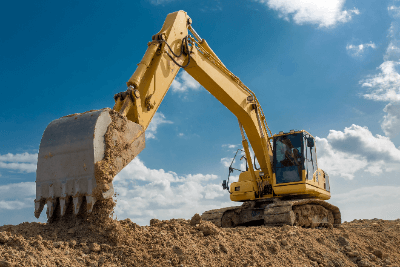What Is a Hydraulic Shovel?

A hydraulic shovel, often seen on construction sites, is a machine equipped with a bucket (shovel).
It is used for digging and leveling the soil. Hydraulic shovels are also commonly referred to as excavators, backhoes, or shovel trucks. Many models of hydraulic shovels have caterpillar tracks at the bottom, allowing them to move stably on slightly uneven surfaces. Additionally, attaching a blade (dirt blade) to the bottom makes it easier to perform leveling tasks.
The operation of a hydraulic shovel is done using about six levers rather than handles. Qualifications are required to operate it during work, and there is often a noticeable difference between those familiar with adjusting the bucket and arm delicately and beginners. Skill is necessary to achieve a clean finish in tasks like leveling. Consequently, practice apps for operating these machines have also been developed.
Recent trends include models that can measure the weight loaded in the bucket and those capable of semi-automatic operation. Additionally, there is a preference for models with low fuel consumption and minimal noise.
Uses of Hydraulic Shovel
Hydraulic shovels are used in construction sites and agricultural work to dig or move soil with the bucket (shovel) portion. Moreover, by attaching different shapes to the bucket, they are employed in the demolition of buildings such as houses and commercial structures, as well as in the dismantling of industrial waste and other materials.
Types with powerful magnets attached to the bucket can attract metals like iron, aiding in metal recovery. Hydraulic shovels operate with significant force due to hydraulic movements, and by rotating only the upper part from the driver’s seat without moving the caterpillar tracks below, loading operations become easier even in narrow spaces.
Principles of Hydraulic Shovels
Hydraulic shovels have working oil pipes running through the driving parts, and the mechanism operates through the hydraulic pressure of the working oil, causing cylinders and motors to function. Initially, the diesel engine is powered, turning the hydraulic pump, which increases the hydraulic pressure of the working oil.
The working oil flowing from the pump is directed by the control valve in the desired direction, causing hydraulic cylinders or hydraulic motors to move, providing the power for rotation or propulsion. There are about six levers and pedals at the driver’s seat, controlling the flow of working oil through their manipulation, thus moving the hydraulic shovel.
While the operation is not overly complex, the numerous levers require careful attention to avoid mistakes. Additionally, the lever positions of the arm and bucket determine the effective operational range, so being conscious during work leads to increased efficiency.
Most hydraulic shovels use light oil as fuel, although specific models may have prescribed fuel requirements. Buckets come in various shapes, such as wide, narrow, flat-faced, or mesh types, depending on the intended use. When switching, it is necessary to standardize the type of hydraulic piping for attachment.
Types of Hydraulic Shovels
Hydraulic shovels come in various types and sizes for applications ranging from construction sites to agriculture and forestry.
1. Classification by Size
Those with a vehicle weight of 6 tons or less or a bucket capacity of less than 0.25 are referred to as mini hydraulic shovels. They are mainly suitable for excavation work in narrow spaces, such as water pipe construction, parks, and gardens. Other categories include medium hydraulic shovels and large hydraulic shovels.
2. Classification by Shape
Generally, they are classified into standard, general-purpose small machines, small swing machines, and rear ultra-small swing machines. The type with a smaller turning radius at the rear of the vehicle compared to the standard type is called an ultra-small swing machine or rear ultra-small swing machine and is used for excavation in narrow areas.
3. Classification by Special Specifications
Hydraulic shovels can perform various tasks, such as crushing, rock cutting, and dredging, by replacing dedicated attachments or exchanging the boom-arm extending from the vehicle with special specifications.
There are also specifications with remote control systems, making it possible to work in disaster sites or tunnel construction where danger is involved.